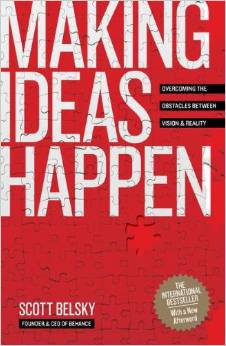By: Chuck Frey
Coming up with a great idea is never enough. You must transform your vision into reality. Helping creative people to do that is the focus of Scott Belsky’s new book, Making Ideas Happen.
Coming up with a great idea is never enough. You must transform your vision into reality.
According to Scott Belsky, founder and CEO of Behance, the ability to successfully implement your ideas isn’t something you’re born with, but rather a set of skills and strategies that can be learned. As he explains in his new book, Making Ideas Happen: Overcoming the Obstacles Between Vision & Reality, you can enhance your ability to execute on your ideas by developing more effective organizational habits and harnessing the support of your colleagues and your community.
In the forward to Making Ideas Happen, Belsky explains that he has devoted his life to studying creative professionals – those people who are “responsible for the designs, entertainment, literature and new businesses that bring meaning to our lives” – but who are also some of the most disorganized people on the planet. That is, they are a font of ideas, but they often lack the knowledge necessary to push them around and through the numerous obstacles that block the path to successful implementation.
To help creatives overcome these challenges, Belsky founded Behance, an online community that helps creative people and teams to organize their work, collaborate and lead others. Based on his research and experiences at Behance, he concluded that creative people who are consistently successful at selling their ideas shared a number of common traits:
- They are well organized and execute relentlessly
- They engage peers and leverage the power of community to build support and momentum for their ideas
- They have developed effective strategies for leading creative teams and projects
The book is divided into three main sections:
1. Organization and execution: Includes a discussion of the Action Method, a process Belsky developed to help creative people to organize their ideas into projects and processes, moving the ball forward and maintaining attention and resolve during the process of implementing your ideas.
2. The forces of community: This section of the book helps you to mobilize and motivate like-minded people to help you build support and momentum for your idea.
3. Leadership capability: In order to develop a sustainable career, creative people need to know how to take leadership and manage creative teams. This section of the book arms you with the leadership skills you’ll need to transform your organization into a more creative one. Finally, this section of Making Ideas Happen focuses on self-leadership, which helps you to tackle what is often the biggest barrier of all – our own limiting tendencies and beliefs.
In short, Making Ideas Happen aims to teach you the strategies you need to know to successfully sell and implement your ideas. As Belsky points out, “The ideas that move industries forward are not the result of tremendous creative insight but rather of masterful stewardship.”
From my personal experience, this observation rings painfully true. How many times have we seen an inferior idea gain traction, while our pet idea steadily loses support?
I recently started reading Making Ideas Happen, and am impressed with its practical approach. Too many business books today are focused on helping people to generate ideas. The fact is that too many ideas are stillborn, because their creators lack the ability to develop them. Belsky’s book promises to be a useful toolkit that will arm the creative reader for the inevitable battles that your great ideas are likely to face.
About the author
Chuck Frey Senior Editor, founded InnovationTools.com and served as its publisher from its launch in 2002 until the partnership with Innovation Management in 2012. He is the publisher of The Mind Mapping Software Blog, the definitive souce for news, trends, tips and best practices for visual mapping tools. A journalist by trade, Chuck has over 14 years of experience in online marketing, and over 10 years experience in business-to-business public relations. His interests include creative problem solving, visual thinking, photography, business strategy and technology. His unique combination of experience and influences enables him to envision new possibilities and opportunities.
Senior Editor, founded InnovationTools.com and served as its publisher from its launch in 2002 until the partnership with Innovation Management in 2012. He is the publisher of The Mind Mapping Software Blog, the definitive souce for news, trends, tips and best practices for visual mapping tools. A journalist by trade, Chuck has over 14 years of experience in online marketing, and over 10 years experience in business-to-business public relations. His interests include creative problem solving, visual thinking, photography, business strategy and technology. His unique combination of experience and influences enables him to envision new possibilities and opportunities.

